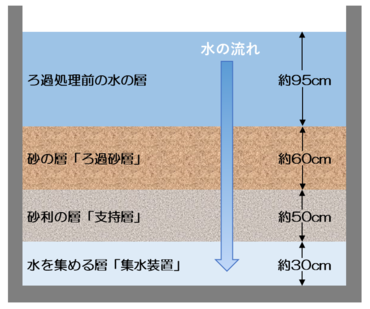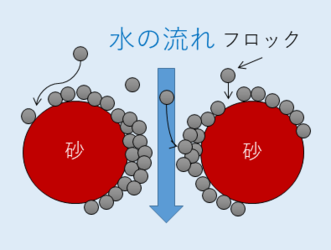Here's the text.
Mechanism of sand filtration
Last Updated January 17, 2024
Structure of the filter pond
The structure of the filtration pond has a "filtration sand layer" that performs filtration to remove fine suspended matter, and there is a "support layer" with gravel underneath it. The support layer of the gravel plays a role in holding down the filter sand at the top so that it does not flow out. Below that, there is a "water collecting device" that collects filtered water.
In this way, fine lumps (flocks) of turbid components that could not be removed in the sinking pond are removed while passing through the filter pond from top to bottom.

Cross-sectional view of the filter pond
Filtration mechanism
Compared to the gap between the filtration sand grains, most of the flocs that flow into the filtration pond are about 1/10/25/10, and pass through the gaps in the filtration sand.
In other words, rapid filtration not only removes large particles in narrow gaps, but also removes small flocks by adsorption to sand particles.
For this reason, if the inflowed turbid components are not clustered (not flocked), most will flow out of the filter pond, so in rapid filtration, by injecting a coagulant in the sediment pond before filtration, it is important to flock the turbid components.
Mechanism of agglomeration and sinking

The state of adsorption to sand
- Actual size of sand approx. 500 micrometers
- Flock size Several micrometers to several tens of micrometers
※1/1,000th of a micrometer 1 millimeter
Inquiries to this page
Water Works Bureau Water Purification Department
Telephone: 045-671-3544
Telephone: 045-671-3544
Fax: 045-212-1158
Email address: su-josui@city.yokohama.lg.jp
Page ID: 792-196-332







